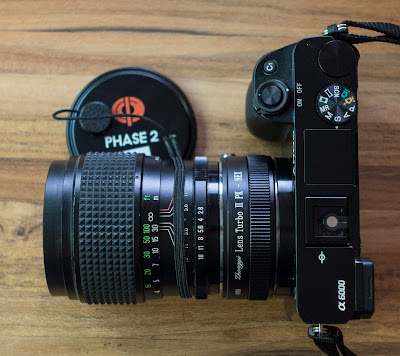This lens was likely made for a local importer by a Japanese manufacturer such as Kobori. But with a brand name like that, try to find out... no information at all.
The lens looks good, as new, with a simple push'n turn zoom and focus. Clear interface with colorful lettering. It has smooth handling and nice weight for stability.
Quality wise, it's nothing special. It can take good pictures, but lacks the super sharpness or rich colors of the Vivitar and Tokina lenses I recently reviewed. So somewhere in the middle for image quality. And a little slow with a maximum aperture of 4.5.
So, conclusion... not a bad lens, not a good lens. I don't think I will keep it in my collection, and for $19.99, with a little bit of hunting, I believe you can find better and faster.
Lens Specification:
Focal Length: 80-200mm
Maximum Aperture: F4.5
Minimum Aperture: F22
Image Format: 35mm
Lens Mount: PK
Optics: unknown
Blades: 6
Focussing: Manual
Minimum Focus: 150cm
Filter Size: 52mm
Weight: 562g
Length: 131-143mm
Production: 1980's?
Serial Number: 1000760
Made In: Japan
Company:
Not much to find on the brand, but then again "Image" is likely to give many false search results. I expect Image is the brand name of a small lens importer, rebranding some of the know or lesser known manufacturers.
MC
MC stands for Multi Coated, a multi-layer lens coating process that cuts the reflection ratio down with as result a dramatic improvement in both color fidelity and brightness and the elimination of flare and ghost images.
Adapter:
Lens Turbo II PK - Nex
Cost: $75, used on B&H PhotoVideo, new for $149
The Pentax K Lens to Sony E-Mount Camera Lens Turbo Adapter Mark II from Mitakon allows Pentax K lenses to be mounted on Sony E-Mount APS-C format cameras, increasing the angle of view by 0.726x and the maximum aperture of the lens by 1 f-stop.The four optical elements of the Lens Turbo adapter condense light from the Pentax K full frame lens and project it onto the camera's APS-C sensor allowing the sensor to capture all of the lens' transmitted light, negating the 1.5x crop factor and effectively producing full-frame coverage on non-full-frame sensors. A corresponding increase in the maximum aperture of 1 f-stop makes the lens more effective in low-light situations.
Samples:
The Mark II version of the Lens Turbo features an improved design to produce sharper images. Its rectangular rear lens rests closer to the camera's sensor improving light transmission and an enhanced lens coating minimizes ghosting and flare. One extra-low dispersion (ED) lens element reduces aberrations for better delineated images. The adapter offers a sturdy metal construction and stainless steel mounts, it attaches to both camera and lens with little play and includes a front and rear protective cap. The Lens Turbo is a manual adapter offering no electronic communication between lens and camera.
 |
| 1/400s - ISO200 - Handheld |
 |
| 1/250s - ISO200 - Handheld |
 |
| 1/500s - ISO200 - Handheld |
 |
| 1/1250s - ISO500 - Handheld |
 |
| 1/800s - ISO500 - Handheld |
 |
| 1/60s - ISO500 - Handheld |



















